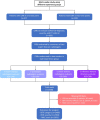Chest radiograph classification and severity of suspected COVID-19 by different radiologist groups and attending clinicians: multi-reader, multi-case study
- PMID: 36282308
- PMCID: PMC9592875
- DOI: 10.1007/s00330-022-09172-w
Chest radiograph classification and severity of suspected COVID-19 by different radiologist groups and attending clinicians: multi-reader, multi-case study
Abstract
Objectives: To quantify reader agreement for the British Society of Thoracic Imaging (BSTI) diagnostic and severity classification for COVID-19 on chest radiographs (CXR), in particular agreement for an indeterminate CXR that could instigate CT imaging, from single and paired images.
Methods: Twenty readers (four groups of five individuals)-consultant chest (CCR), general consultant (GCR), and specialist registrar (RSR) radiologists, and infectious diseases clinicians (IDR)-assigned BSTI categories and severity in addition to modified Covid-Radiographic Assessment of Lung Edema Score (Covid-RALES), to 305 CXRs (129 paired; 2 time points) from 176 guideline-defined COVID-19 patients. Percentage agreement with a consensus of two chest radiologists was calculated for (1) categorisation to those needing CT (indeterminate) versus those that did not (classic/probable, non-COVID-19); (2) severity; and (3) severity change on paired CXRs using the two scoring systems.
Results: Agreement with consensus for the indeterminate category was low across all groups (28-37%). Agreement for other BSTI categories was highest for classic/probable for the other three reader groups (66-76%) compared to GCR (49%). Agreement for normal was similar across all radiologists (54-61%) but lower for IDR (31%). Agreement for a severe CXR was lower for GCR (65%), compared to the other three reader groups (84-95%). For all groups, agreement for changes across paired CXRs was modest.
Conclusion: Agreement for the indeterminate BSTI COVID-19 CXR category is low, and generally moderate for the other BSTI categories and for severity change, suggesting that the test, rather than readers, is limited in utility for both deciding disposition and serial monitoring.
Key points: • Across different reader groups, agreement for COVID-19 diagnostic categorisation on CXR varies widely. • Agreement varies to a degree that may render CXR alone ineffective for triage, especially for indeterminate cases. • Agreement for serial CXR change is moderate, limiting utility in guiding management.
Keywords: Coronavirus; Diagnosis; Observer variation; X-ray.
© 2022. The Author(s).
Conflict of interest statement
The authors of this manuscript declare relationships with the following companies:
AN reports a medical advisory role with Aidence BV, an artificial intelligence company; AN reports a consultation role with Faculty Science Limited, an artificial intelligence company.
SH and SM report grants from the National Institute for Health Research (NIHR) outside the submitted work.
JJ reports Consultancy fees from Boehringer Ingelheim, F. Hoffmann-La Roche, GlaxoSmithKline, NHSX; is on the Advisory Boards of Boehringer Ingelheim, F. Hoffmann-La Roche; has received lecture fees from Boehringer Ingelheim, F. Hoffmann-La Roche, Takeda; receives grant funding from GlaxoSmithKline; holds a UK patent (application number 2113765.8).
The other authors of this manuscript declare no relationships with any companies, whose products or services may be related to the subject matter of the article.
Figures




Similar articles
-
COVID-19 pneumonia chest radiographic severity score: variability assessment among experienced and in-training radiologists and creation of a multireader composite score database for artificial intelligence algorithm development.Br J Radiol. 2022 Jun 1;95(1134):20211028. doi: 10.1259/bjr.20211028. Epub 2022 May 5. Br J Radiol. 2022. PMID: 35451863 Free PMC article.
-
Multi-Radiologist User Study for Artificial Intelligence-Guided Grading of COVID-19 Lung Disease Severity on Chest Radiographs.Acad Radiol. 2021 Apr;28(4):572-576. doi: 10.1016/j.acra.2021.01.016. Epub 2021 Jan 18. Acad Radiol. 2021. PMID: 33485773 Free PMC article.
-
Multireader evaluation of radiologist performance for COVID-19 detection on emergency department chest radiographs.Clin Imaging. 2022 Feb;82:77-82. doi: 10.1016/j.clinimag.2021.10.018. Epub 2021 Nov 12. Clin Imaging. 2022. PMID: 34798562 Free PMC article.
-
Review of Chest Radiograph Findings of COVID-19 Pneumonia and Suggested Reporting Language.J Thorac Imaging. 2020 Nov 1;35(6):354-360. doi: 10.1097/RTI.0000000000000541. J Thorac Imaging. 2020. PMID: 32520846 Review.
-
Thoracic imaging tests for the diagnosis of COVID-19.Cochrane Database Syst Rev. 2020 Nov 26;11:CD013639. doi: 10.1002/14651858.CD013639.pub3. Cochrane Database Syst Rev. 2020. Update in: Cochrane Database Syst Rev. 2021 Mar 16;3:CD013639. doi: 10.1002/14651858.CD013639.pub4. PMID: 33242342 Updated.
Cited by
-
Detection of Severe Lung Infection on Chest Radiographs of COVID-19 Patients: Robustness of AI Models across Multi-Institutional Data.Diagnostics (Basel). 2024 Feb 5;14(3):341. doi: 10.3390/diagnostics14030341. Diagnostics (Basel). 2024. PMID: 38337857 Free PMC article.
-
Use of reporting templates for chest radiographs in a coronavirus disease 2019 context: measuring concordance of radiologists with three international templates.J Med Imaging (Bellingham). 2024 Jul;11(4):045504. doi: 10.1117/1.JMI.11.4.045504. Epub 2024 Aug 28. J Med Imaging (Bellingham). 2024. PMID: 39211829
-
Prognostic Value of the Brixia Radiological Score in COVID-19 Patients: A Retrospective Study from Romania.Trop Med Infect Dis. 2025 May 12;10(5):130. doi: 10.3390/tropicalmed10050130. Trop Med Infect Dis. 2025. PMID: 40423360 Free PMC article.
-
Explained Deep Learning Framework for COVID-19 Detection in Volumetric CT Images Aligned with the British Society of Thoracic Imaging Reporting Guidance: A Pilot Study.J Imaging Inform Med. 2025 Feb 26. doi: 10.1007/s10278-025-01444-3. Online ahead of print. J Imaging Inform Med. 2025. PMID: 40011345
References
-
- Guan WJ, Zhong NS. Clinical characteristics of Covid-19 in China. Reply N Engl J Med. 2020;382(19):1861–1862. - PubMed
-
- Public Health England(2020) COVID-19: investigation and initial clinical management of possible cases [updated 12/14/2020. Available from: https://www.gov.uk/government/publications/wuhan-novel-coronavirus-initi.... Accessed 23 Dec 2021
MeSH terms
Grants and funding
LinkOut - more resources
Full Text Sources
Medical

